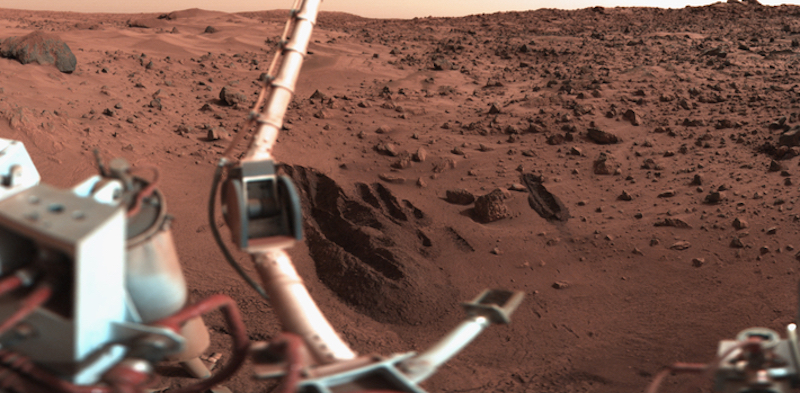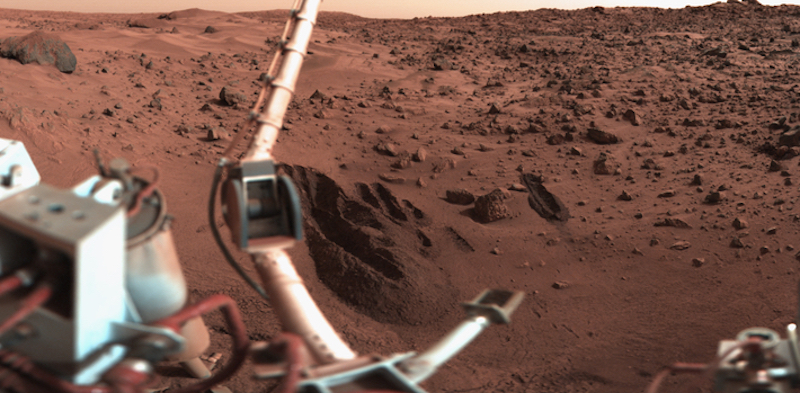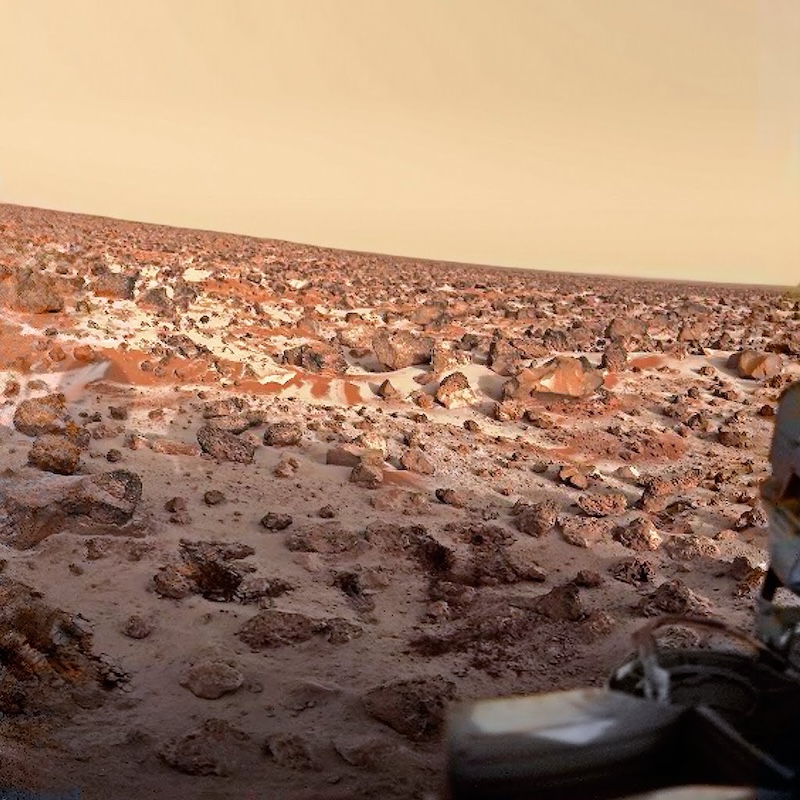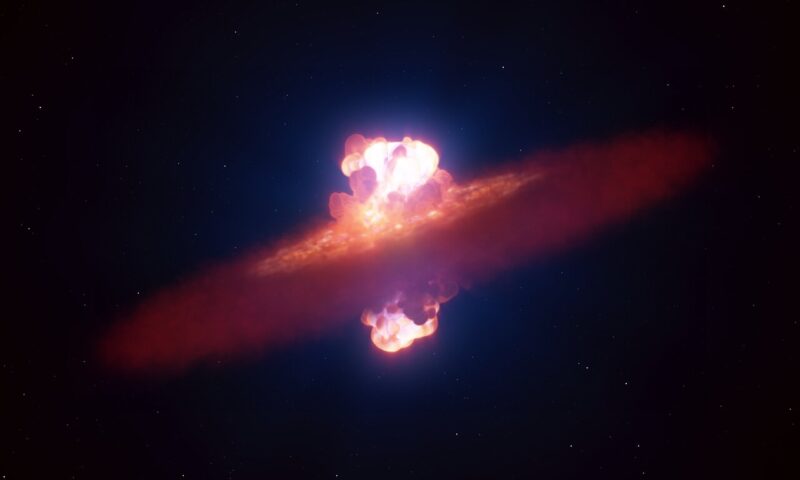Now Reading: Was NASA’s ‘no life on Mars’ conclusion in the 70s wrong?
-
01
Was NASA’s ‘no life on Mars’ conclusion in the 70s wrong?
Was NASA’s ‘no life on Mars’ conclusion in the 70s wrong?


- NASA’s twin landers, Viking 1 and 2, searched for microbial life on Mars in the late 1970s. The results were tentatively positive but inconclusive.
- NASA later declared ‘no life on Mars’ when the landers failed to find organic molecules. They actually did find two types of organics, but scientists thought they were contaminants from the landers themselves.
- Similar organics have since been found on Mars, however, by subsequent rover missions. So if the organics were there, does that mean Viking found life after all?
The Viking search for life on Mars
Did a big mistake back in the late 1970s lead to scientists concluding that there was no microbial life on Mars? That’s what astrobiologist Dirk Schulze-Makuch at the Technical University Berlin in Germany says might have happened in a new article for Big Think. After NASA’s Viking landers touched down on Mars in 1976, they conducted lab experiments to search for evidence of active microbes in the Martian sands. While initial results were positive, scientists later concluded there was no life because the landers didn’t find any organic molecules in the soil. Or did they … ?
As Schulze-Makuch notes, they actually did find two kinds of organics. But at the time, they were thought to be contaminants from the landers themselves. But now rovers have also found similar organics, suggesting they are native to Mars after all. Could that mean Viking actually did find life after all?
Schulze-Makuch, along with Steve Benner at the Foundation for Applied Molecular Evolution and three other colleagues, sent an eLetter to the journal Science. The letter is in response to a paper initially published on October 1, 1976.
A team of scientists at FfAME (Steve Benner, Jan Spacek, Clay Abraham) joined European astrobiologist Dirk Schulze-Makuch to publish this eLetter in Science that reexamines, at last, a misinterpretation published in Science by Klaus Biemann and his coworkers. Links below!
— Foundation for Applied Molecular Evolution (@ffame.org) 2025-10-22T16:40:55.868Z
The eLetter is appended to the bottom of the Biemann et al. abstract at the link:www.science.org/doi/10.1126/…
— Foundation for Applied Molecular Evolution (@ffame.org) 2025-10-22T16:40:55.869Z
Positive, but inconclusive results
The two landers – Viking 1 and Viking 2 – were a unique mission. They were designed specifically to look for signs of microbial life in the sandy Martian soil. The instruments included the Labeled Release Experiment to test for metabolic processes; the Pyrolytic Release Experiment to test for organic synthesis reactions and the Gas Exchange Experiment to measure exchange of gases that might be biological in origin.
Some of the results were positive, but others were harder to figure out. As Schulze-Makuch wrote:
Even though the very first test at Viking 1’s Chryse landing site had been positive for organic synthesis (with a 99.7% certainty compared to the control sample), follow-on tests provided no clear results. The gas exchange experiment was just as puzzling: It showed the release of several gases, including oxygen, but scientists today still don’t agree on an explanation.

No organics?
Even though some tests were positive, there was one big problem. Klaus Biemann, a principal investigator for the Viking mission, reported that the landers had not found any organics. Organic molecules are the building blocks of life, so without them, there can’t be any life. This led to NASA declaring there was no life on Mars, at least not where the two landers landed. In fact, Gerald Soffen, Viking’s project scientist, confidently declared:
No organics, no life on Mars.

Organics on Mars after all
But that wasn’t quite the final word. Viking did, in fact, find two kinds of organics, methyl chloride (aka chloromethane) and methylene dichloride (aka dichloromethane), which are chlorinated compounds. They were at low levels, but they were there. The mission team at the time, however, thought that they were probably contaminants from the landers themselves. Was that a wrong assumption?
Later, NASA’s rovers Curiosity and Perseverance, both still active today, also found similar organic molecules. In addition to a multitude of other organic molecules that both rovers have also discovered, some surprisingly complex. Which, of course, raises a big question. Were those organics detected by Viking indigenous to Mars after all? And if so, how did that affect the “no life” conclusion?
Although puzzling in some ways, the results from the Viking experiments were largely consistent with what scientists expected to see if indeed there were living microbes. But the “lack” of organics forced a different conclusion.
Schulze-Makuch argues that scientists at the time were too focused on non-life explanations. He wrote:
Scientists of the time were too focused on abiotic – that is, non-biological – answers for the puzzling Viking results, even those that made little sense. Instead, they should have kept their minds open to biological explanations as well.

Where do we go from here?
Based on the Viking data alone, we unfortunately still can’t say for sure whether the landers did find life on Mars or not. Indeed, the results continue to be a subject of much debate. The only way to answer this exciting but controversial question is to go back to Mars with a new mission specifically designed to look for extant life. No mission since Viking has done that. Subsequent missions instead focused on finding evidence of water and habitable environments in the distant past.
That includes the current rovers Curiosity and Perseverance. Both have found tantalizing clues, but not proof yet of ancient microbial life. As Schulze-Makuch notes:
The first step on that journey is to correct an old mistake that shaped the course of Mars exploration for 50 years. The second step is to launch a new robotic mission dedicated explicitly to the search for life. Such a mission would be a worthy successor to Viking, using 21st-century technology and a more realistic, up-to-date scientific understanding of planet Mars.
Bottom line: In the late 1970s, NASA declared ‘no life on Mars’ when the Viking landers failed to find organic molecules (but they did). So was that conclusion a mistake?
Read more: Did we find life on Mars … and then wipe it out?
Read more: Did Viking 1 land on debris from an ancient megatsunami?
The post Was NASA’s ‘no life on Mars’ conclusion in the 70s wrong? first appeared on EarthSky.
Stay Informed With the Latest & Most Important News
Previous Post
Next Post
-
 012024 in Review: Highlights from NASA in Silicon Valley
012024 in Review: Highlights from NASA in Silicon Valley -
 02Panasonic Leica Summilux DG 15mm f/1.7 ASPH review
02Panasonic Leica Summilux DG 15mm f/1.7 ASPH review -
 03How New NASA, India Earth Satellite NISAR Will See Earth
03How New NASA, India Earth Satellite NISAR Will See Earth -
 04And Thus Begins A New Year For Life On Earth
04And Thus Begins A New Year For Life On Earth -
 05Astronomy Activation Ambassadors: A New Era
05Astronomy Activation Ambassadors: A New Era -
06SpaceX launch surge helps set new global launch record in 2024
-
 07Space Force plans new ‘Futures Command’ amid pressure to speed up modernization
07Space Force plans new ‘Futures Command’ amid pressure to speed up modernization




















